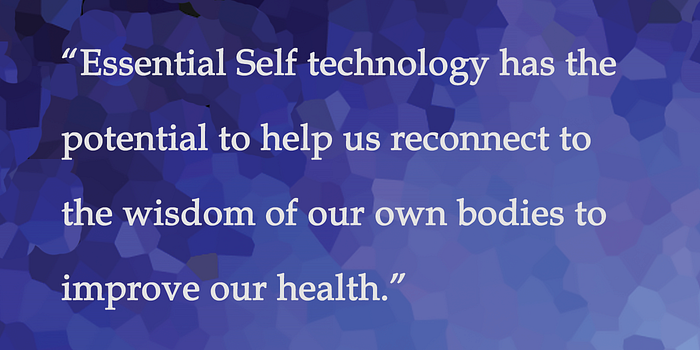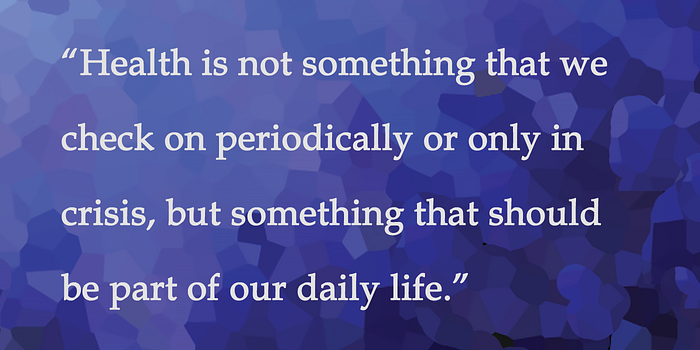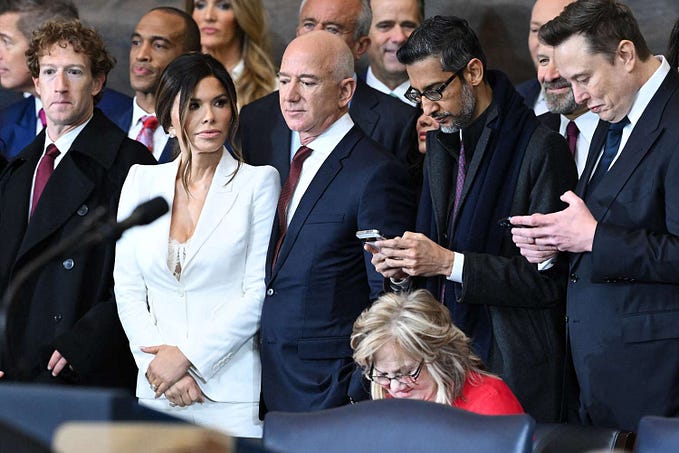Can Technology Help Us Connect With Our Essential Self?
An Interview with Psychology Professor Howard Nusbaum

From pedometers and Fitbits to calorie tracking apps, many of us have experimented with various personal technologies to help us track how much we exercise, eat and sleep to inspire us to do more of what’s good for our health and less of what’s harmful. But how far can technology go in supporting better health? Are there new boundaries to push? Can we connect technology and self more directly? Linda Stone, who was featured on our Pioneering Ideas podcast, recently introduced us to the emerging field of Essential Self Technologies, which use sensors and the body’s own wisdom to improve health. With our support, Linda and her colleague Howard Nusbaum, a psychology professor at the University of Chicago, lead a professional network charged with charting a course for Essential Self technology — and with helping us to explore its potential impact on our effort to build a Culture of Health. I recently sat down with Howard to learn more about his work.

Lori Melichar: Tell me about Essential Self technology. What is it, why is it important?
Howard Nusbaum: Most of us are familiar with devices like Fitbit that help us track how many steps we take during the day, how much and how well we’re sleeping, what our blood-oxygen levels are, et cetera. Those devices are examples of what’s called Quantified Self technology. They collect and monitor and analyze your personal health data, so that you can change your behavior — by walking more, for example, or eating less. In this scenario, technology is kind of your personal health coach.
Essential Self technology goes a step further. It’s not your personal health coach — it’s your personal health agent. It improves your health for you.
For example, what if you had a device that could actually slow your heart rate when you’re anxious or upset by changing ambient noise or resetting the lighting to help you feel calmer? Or, what if, instead of an ergonomic chair that you have to adjust yourself to accommodate your height and size and so forth, you had a chair that adjusts itself so that you’re sitting in a way that’s healthier for you? Essential Self technology has the potential to help us reconnect to the wisdom of our own bodies to improve our health.
Melichar: How did you come to discover the concept of Essential Self technology?
Nusbaum: I came to Essential Self technology from two directions. The first had to do with some work I did with the John Templeton Foundation on wisdom. In my view, wisdom is about making practical decisions in your daily life that don’t just benefit yourself, but benefit others as well. Walter Cannon, a physiologist, has explored what he called the wisdom of the body, and the fact that your body “knows” things about how to be healthy, even when you’re not consciously aware of them. Another researcher, Gary Berntson, who’s a biological psychologist, talks about how emotions affect your health — so if you have a particular heart condition and you have a very emotional experience, for example, you might die. The converse is that your body can actually make you a little healthier if you nudge it in the right direction, the right way.
With the grant from the Templeton Foundation, we study things such as: if people engage in a practice like meditation, which has positive benefits for both the heart and for the mind, does that increase cognitive wisdom? It turns out that it does, or at least it’s related to increases in wisdom. We also found that people who engage in ballet for years are higher in wisdom. This suggests that there’s a great deal more to learn about the wisdom of the body.
The second direction by which I came to thinking about Essential Self technology has to do with Linda Stone’s ideas about the Quantified Self movement and her approach to personal well-being and her advocacy for Essential Self. She believes that some of the demands that the Quantified Self movement place on people to change their behavior and regulate their lives are too high. For example, research shows that six months after starting to use a Fitbit or similar technology, a number of the people who bought the devices stopped using them.

So this kind of technology for improving health is just not going to work for a lot of people. Linda speculated that perhaps there are ways to make the technology itself an agent of change. Instead of making you think about and change your health, the technology would change your health for you.
Melichar: When Linda came to you with the idea of teaming up to apply for a grant, how did you see Essential Self technology fitting into what we at the Robert Wood Johnson Foundation are trying to accomplish to build a Culture of Health in the U.S.? (Readers: To hear more on this idea directly from Linda, listen to her audio essay in episode eight of our Pioneering Ideas podcast.)
Nusbaum: In the United States and other countries, most people “disattend” to their health on a daily basis. That is, they aren’t very conscious of their health unless it isn’t good. They live day to day and see their doctor once a year, if they even do that, and that’s when they think about their health. It’s a pretty impoverished notion of what health is. So the Robert Wood Johnson Foundation is asking how we can change that and how we can build a Culture of Health. In my view, when people use something like Essential Self technology they become more aware and proactive about their health and begin to be more actively engaged in all aspects of their health — from products they buy to questions they ask their doctor. That whole cascade effect of awareness and knowledge can help contribute to a Culture of Health.
Melichar: How do you talk about all this in a nutshell with people?
Nusbaum: I think about Essential Self technology in the context of “nudge” policies, as described in a very influential book called Nudge by Richard Thaler and Cass Sunstein. The idea is that people have certain economic behavioral goals, but if they have only a short-term focus or interest, they don’t achieve those goals. They do things that work against their long-term goals, even though they want to achieve those goals. The nudge policies are small ways of helping people do the things they want to do. I think about Essential Self technology in that context. Essential Self technologies should be about achieving one’s health goals — whether they’re restorative, reparative, or simply preventative or maintenance. What kinds of technologies can we give to people that will help nudge their physiology and behavior in the direction of better health? That’s my starting point for this.

Melichar: So what are your favorite examples of Essential Self technologies?
Nusbaum: This is really still an emerging field so there aren’t yet many examples to draw from — but I saw one device recently that’s close to what Essential Self technology might look like. It measures your posture when you’re sitting — the angles of your thorax and chest and so forth — and, based on those measurements, it produces a vibration designed to get you into a better posture. That’s important, because when people are engaged in email, working at the computer, they tend to hunch over and compress their thorax, which restricts breathing. If you were wearing one of these devices and you started hunching over as you’re working at your computer, and therefore compressing your thorax and reducing oxygen intake, the device would vibrate and remind you to sit up. That’s a hypothetical example.
Other technologies might help people deal with daily stress. Maybe you’ve gotten a harsh email or a deadline is looming, and when that happens, your heart rate changes and your blood pressure changes. An Essential Self technology might adjust ambient lighting or sound or even temperature to help slow your heart rate down.
There are devices that claim to produce vagus nerve stimulation and others that claim to produce transcranial electric stimulation that can help you to either relax or be more alert. I don’t know if they’re safe and I don’t know if they’re effective, but those ideas are the kinds of things that I think are in the vein of what might be developed, and these are questions we are exploring through our RWJF grant.
Melichar: My favorite example of Essential Self technology is Kelly Dobson’s OMO, or “companion robot” that you put on somebody’s chest to help them calm down and regulate their breathing.
Nusbaum: It’s pretty impressive how the OMO works. It’s like a large pillow that you clutch to your chest, and it feels like a living, breathing thing against you. People say it makes them feel good. I have a Newfoundland dog, Otto, and he serves the same purpose.

Melichar: I know you’re just getting into this work, but what are your key goals?
Nusbaum: Most importantly, we want people to start thinking that health is not something that we check on periodically or only in crisis, but something that should be part of our daily life. And we want them to think about the kinds of devices in Essential Self technology that could help them make health part of their daily lives. For me, this dovetails with thinking about body wisdom and what that means in terms of physiology and psychology. We tend to think about our psychology and our physiology as different things, but the notion that what our bodies do and how our minds operate are not really separate things is a fundamental scientific problem that we have not addressed well yet in science.
Melichar: How do people learn more about your work, and how can they help to move this effort forward?
Nusbaum: Visit our website, wisdomcenter.uchicago.edu and subscribe to our feed and read the posts there. We’re fortunate that interest has been high and we’ve had thousands of regular visitors. We also plan to ramp up our website with blog posts, videos of our talks, and more information in general on Essential Self technology in the coming months, so stay tuned!
But to really propel this work forward, we need many more people to join us across different fields and disciplines. This is such an emerging space that we don’t know yet all who we really need at the table — technologists, artists, designers, social scientists and others. We want your input and ideas.
Does this work interest you? Do you have examples of other instances that might be considered an Essential Self technology? Perhaps you are using Essential Self technologies or trying to create Essential Self devices. Share your thoughts and ideas below.









